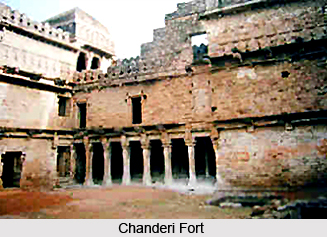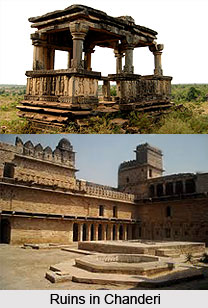Chanderi is the medieval town of Madhya Pradesh. This place is a major centre of Jain pilgrimage importance. This area is also famous for Chanderi fort.
Location of Chanderi
Chanderi is a census town of historical importance in Ashoknagar District of the state of Madhya Pradesh. Canderi is situated at a distance of 127 km from Shivpuri, 37 km from Lalitpur, 55 km from Ashok Nagar and about 45 km from Isagarh. Chanderi is surrounded by residual hills southwest of the Betwa River. Chanderi is surrounded by hills, lakes and forest. This place is spotted with several monuments of the Bundela Rajputs and Malwa sultans. Chanderi is located at 24.72 degree North to 78.13 degree East. It has an average elevation of 456 metres (1496 feet).
History of Chanderi
Chanderi is located strategically on the borders of Malwa and Bundelkhand.  The history of Chanderi goes back to the 11th century, when it was dominated by the trade routes of Central India and was proximate to the arterial route to the ancient ports of Gujarat as well as to Malwa, Mewar, Central India and the Deccan Region of Central India. Consequently, Chanderi became an important military outpost in medieval and modern era. The town of Chanderi also finds mention in Mahabharata, Indian epic. Shishupal was the king of Chanderi during the Mahabharata period. Chanderi is mentioned by the Alberuni in the year 1030. Ghiyas-ud-din Balban captured the city in 1251 for Nasir ud din Mahmud, Sultan of Delhi. Sultan Mahmud I Khilji of Malwa captured the city in the year 1438 after a siege of several months. In 1520 Rana Sanga of Mewar captured the city, and gave it to Medini Rai, a rebellious minister of Sultan Mahmud II of Malwa.
In the year 1540, Chanderi was captured by Sher Shah Suri, and added to the governorship of Shujaat Khan. Mughal Emperor Akbar made the city a sarkar in the subah of Malwa. According to Ain-e-Akbari, the autobiography of Akbar, Chanderi had 14000 stone houses and boasted of 384 markets, 360 spacious caravan sarais (resting place) and 12,000 mosques. The Bundela Rajputs captured the city in 1586, and it was held by Ram Sab, a son of Raja Madhukar of Orchha. In the year 1680 Devi Singh Bundela was made governor of the city, and Chanderi remained in the hands of his family until it was annexed in 1811 by Jean Baptiste Filose for the Maratha ruler Daulat Rao Sindhia of Gwalior. The city of Chanderi was transferred to the British East India Company in the year 1844. The British East India Company lost the control of the city during the Revolt of 1857, and the city was recaptured by Sir Hugh Rose on 14 March 1858. Richard Harte Keatinge led the assault, for which he was awarded the Victoria Cross. The city of Chanderi was transferred back to the Sindhias of Gwalior in 1861, and became part of Isagarh District of Gwalior state. After the independence of India in the year 1947, Gwalior became part of the new state of Madhya Bharat, which was merged into Madhya Pradesh on 1 November 1956.
The history of Chanderi goes back to the 11th century, when it was dominated by the trade routes of Central India and was proximate to the arterial route to the ancient ports of Gujarat as well as to Malwa, Mewar, Central India and the Deccan Region of Central India. Consequently, Chanderi became an important military outpost in medieval and modern era. The town of Chanderi also finds mention in Mahabharata, Indian epic. Shishupal was the king of Chanderi during the Mahabharata period. Chanderi is mentioned by the Alberuni in the year 1030. Ghiyas-ud-din Balban captured the city in 1251 for Nasir ud din Mahmud, Sultan of Delhi. Sultan Mahmud I Khilji of Malwa captured the city in the year 1438 after a siege of several months. In 1520 Rana Sanga of Mewar captured the city, and gave it to Medini Rai, a rebellious minister of Sultan Mahmud II of Malwa.
In the year 1540, Chanderi was captured by Sher Shah Suri, and added to the governorship of Shujaat Khan. Mughal Emperor Akbar made the city a sarkar in the subah of Malwa. According to Ain-e-Akbari, the autobiography of Akbar, Chanderi had 14000 stone houses and boasted of 384 markets, 360 spacious caravan sarais (resting place) and 12,000 mosques. The Bundela Rajputs captured the city in 1586, and it was held by Ram Sab, a son of Raja Madhukar of Orchha. In the year 1680 Devi Singh Bundela was made governor of the city, and Chanderi remained in the hands of his family until it was annexed in 1811 by Jean Baptiste Filose for the Maratha ruler Daulat Rao Sindhia of Gwalior. The city of Chanderi was transferred to the British East India Company in the year 1844. The British East India Company lost the control of the city during the Revolt of 1857, and the city was recaptured by Sir Hugh Rose on 14 March 1858. Richard Harte Keatinge led the assault, for which he was awarded the Victoria Cross. The city of Chanderi was transferred back to the Sindhias of Gwalior in 1861, and became part of Isagarh District of Gwalior state. After the independence of India in the year 1947, Gwalior became part of the new state of Madhya Bharat, which was merged into Madhya Pradesh on 1 November 1956.

Chanderi as a Jain Pilgrimage Centre
Chanderi is a major Jain pilgrimage centre in Madhya Pradesh. Chanderi was a major center of the Parwar Jain community in ancient times, medieval era and the modern time also. There are a number of Jain places nearby- Gurilagiri (7 km), Aamanachar (29 km), Bithala (19 km), Bhamon (16 km), Khandargiri (2 km), Thuvanji (22 km) and Bhiyadant (14 km), and Deogarh, Uttar Pradesh (20 km, across the border of Madhya Pradesh.
Buddhi Chanderi
Buddhi (old) Chanderi, which is also known as old Chanderi is a historical centre in Madhya Pradesh. Buddhi Chanderi is situated on the banks of Urvashi River. It is believed that the Chaidnagar mentioned in Puranas is same as Buddhi Chanderi. There is a myth that when Raja Nala left Damayanti asleep in the forests of Narwar she moved through dense forests and reached Chaidnagar protecting her self from wild animals. The route through forests from Narwar to Chanderi is very short. A number of 9th and 10th century Jain temples are there in Buddhi Chanderi attracting thousands of Jain pilgrims from all over the country.



















